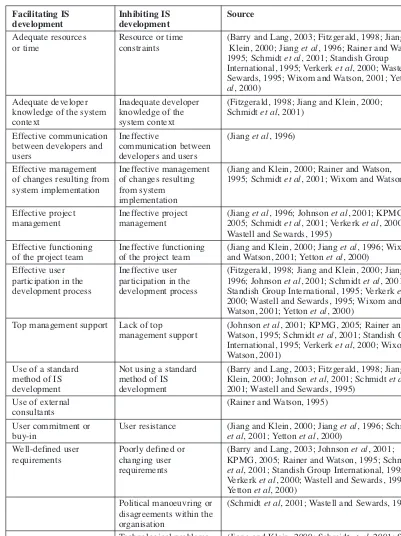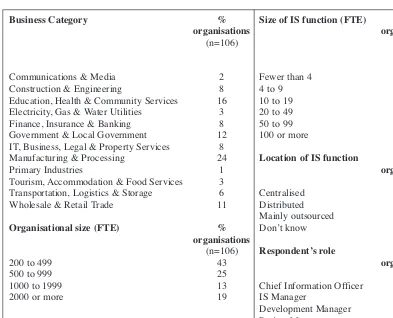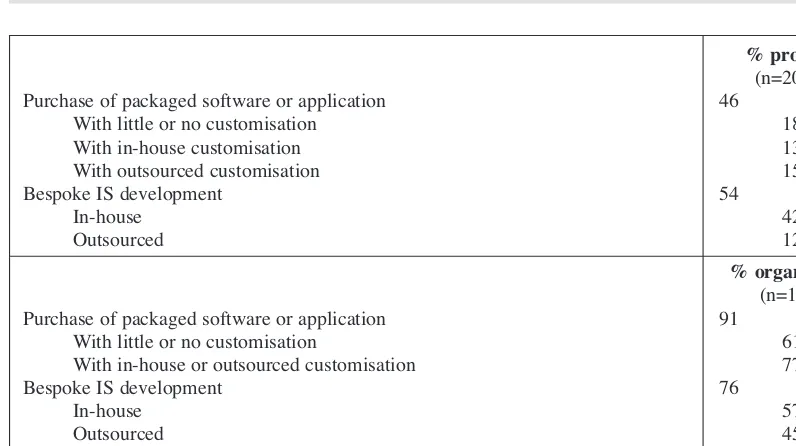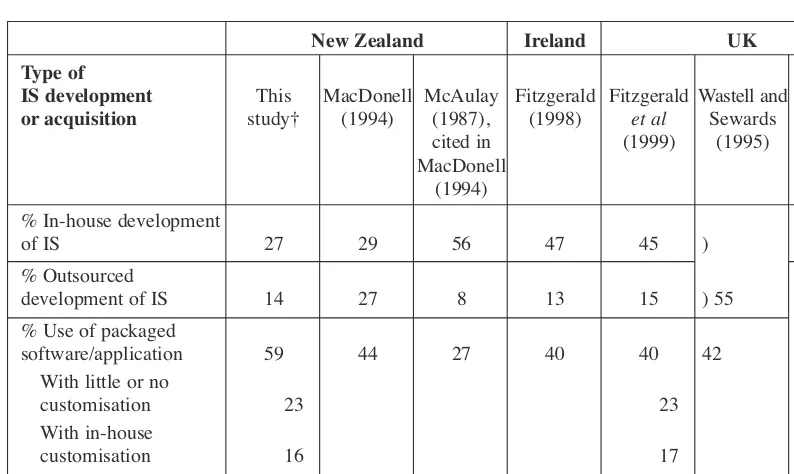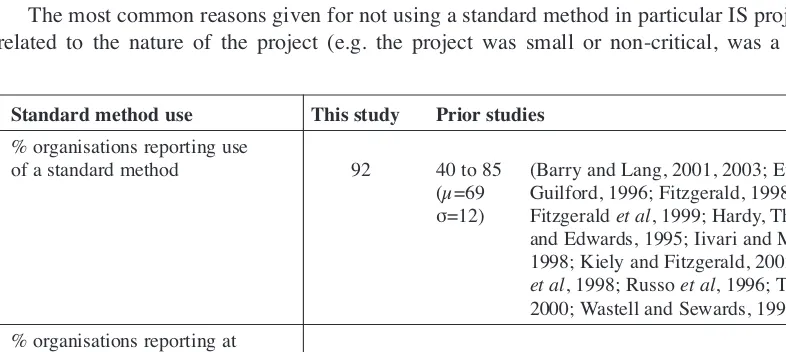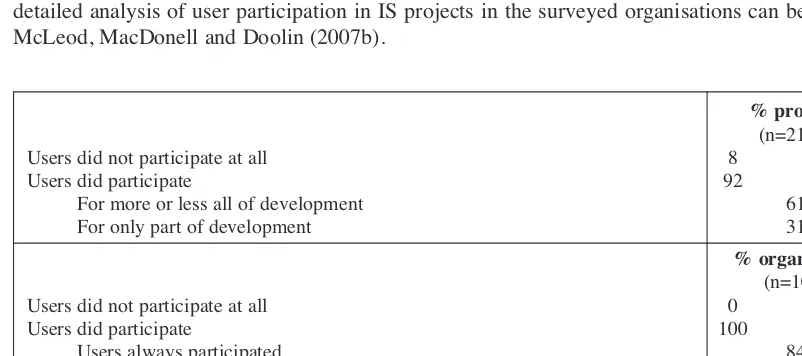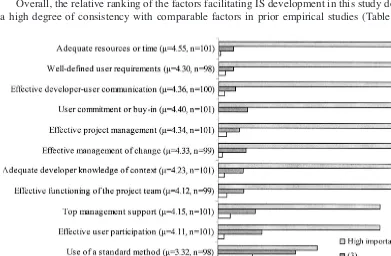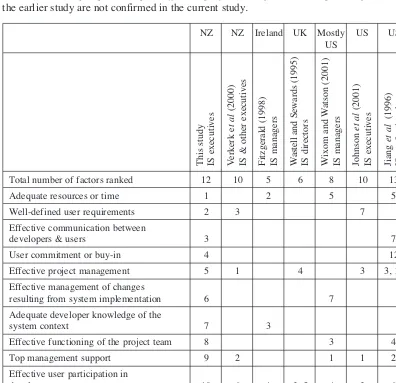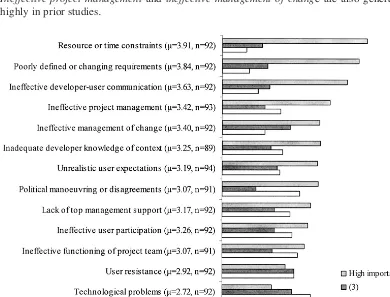Laurie McLeod, Stephen MacDonell and Bill Doolin Auckland University of Technology
Private Bag 920006, Auckland, New Zealand {laumcl88, smacdone, bdoolin}@aut.ac.nz
A survey of New Zealand organisations with 200 or more full-time employees was undertaken in order to obtain an updated assessment of IS development practice. Over the period surveyed (2001-2003), larger organisations (500 or more FTEs) or those with larger IS functions (10 or more IS FTEs) undertook significantly more IS projects, more expensive projects, more projects in which users participated and more projects in which a standard method was used, than their smaller counterparts. In the same period, there has been a trend towards increased use of packaged software solutions and outsourced development or customisation of packaged solutions. Factors perceived as most important to facili tating or inhibiting development in actual IS projects were related to availability of resources, definition of user requirements, communication between developers and users, project management, management of IS development-related change, and developer knowledge of the IS development context.
Keywords: IS development, IS projects, New Zealand
ACM Classification: D.2.9 (Software Engineering – Management); K.6.1 (Management of Computing and Information Systems – Project and People Management), K.6.3 (Management of Computing and Information Systems – Software Management)
Manuscript received: 26 November 2007 Communicating Editor: Graham Low
Copyright© 2009, Australian Computer Society Inc. General permission to republish, but not for profit, all or part of this material is granted, provided that the JRPIT copyright notice is given and that reference is made to the publication, to its date of issue, and to the fact that reprinting privileges were granted by permission of the Australian Computer Society Inc. 1. INTRODUCTION
Surveys investigating the development of computer-based information systems (IS) throughout the world have featured in academic research for several decades, motivated by a desire to depict and improve common, if not ‘best’, practice (Ljung and Allwood, 1999).
To address these issues, a survey was conducted of IS development practices in recent IS projects in New Zealand organisations. Surveys are a useful tool for gathering descriptive information from a large sample, providing a ‘snapshot’ of current practice (Fitzgerald, Philippidis and Probert, 1999; Wynekoop and Russo, 1995; 1997). This paper reports the results of that survey. Three research objectives underlie the study:
1. To obtain an updated picture of actual IS development practices in New Zealand organisations. 2. To compare IS development practices in New Zealand organisations with those reported in other
national contexts.
3. To explore whether a changing IS development environment has affected IS development practices.
The remainder of the paper is structured as follows. First, we review prior empirical studies of IS development practice and examine their scope and outcomes. We then outline the development of our survey instrument and the data collection procedure used in this study. Subsequent sections present and discuss the results of the survey, before some concluding remarks are made about the findings.
2. PRIOR STUDIES OF IS DEVELOPMENT PRACTICE
Numerous academic studies have examined aspects of IS development and the influence of a variety of factors in facilitating or inhibiting development. However, many of these have been focused on one or a few specific factors, practices or methods – relatively few studies have attempted to provide a broad and comprehensive picture of IS development practice (as is the intent here). Of those studies that do, some have surveyed IS executives about the factors that affect IS development (e.g. Verkerk, Bailey, Sundakov and Duncan, 2000; Yetton, Martin, Sharma and Johnston, 2000), while others have asked various groups associated withIS development to give their opinion on the relative importance of such factors (e.g. Fitzgerald, 1998; Schmidt, Lyytinen, Keil and Cule, 2001). These studies and those described below therefore provide an appropriate international benchmark against which the current survey outcomes can be compared. Rather than review them here, actual practices identified in these studies are described in relation to those found in the New Zealand survey, reported in Section 4 of this paper. The remainder of this section therefore addresses prior research that has sought to identify factors influencing effective IS development and their consequent impact on development outcomes.
Most of these prior studies discuss practices that are considered to influence the success (or failure) of IS development. However, “success” is a problematic concept to define and measure. For example, success may be variously defined in terms of IS development process performance, the technical quality of its product, or user satisfaction with the product (Barki, Rivard and Talbot, 2001; Markus and Mao, 2004). This lack of consensus exists not only in the academic literature, but also extends into IS practice (KPMG, 2005; Verkerk et al, 2000). For this reason, in our paper and the survey, we refer more generically to practices that “facilitate” or “inhibit” IS development. By facilitatewe mean to make easier or less difficult; help forward; to assist the progress of; or to increase the likelihood, strength, or effectiveness of. By inhibitwe mean to restrain, hinder, arrest, or check; to repress, discourage, obstruct; or to limit the range or extent of.
Standish Group study (Johnson, Boucher, Connors and Robinson, 2001). In ranking various factors facilitating successful IS development, Irish IS managers surveyed by Fitzgerald (1998) considered user participation to be most important, while adherence to a formal standard method and developer technical expertise were considered the least important.
In their survey of UK IS directors, Wastell and Sewards (1995) found that changing user requirements, insufficient user training and consultation, weak project management and organisational politics all had an inhibiting effect on successful IS development. By comparison, US IS executives participating in the 1994 Standish Group study considered lack of user input, incomplete or changing requirements, and lack of top management support as important inhibiting factors (Standish Group International, 1995). A more recent global survey of IS project management iden ti fied unclear or changing requirements, poor project management processes, and a lack of top manage -ment support, as the three main reasons why IS develop-ment had been inhibited (KPMG, 2005).
Although they did not exactly address the same IS development practice issues as covered here, two additional prior surveys are relevant to the work undertaken in the current study as they were conducted (at least in part) in New Zealand. In 1999, Verkerk et alsurveyed New Zealand IS and other executives, in order to compare IS project outcomes in the public and private sectors (Verkerk et al, 2000). They found that there was a high level of commonality across the sectors in terms of the top six factors affecting project success, project failure and problematic outcomes. For example, professional project management and top management support were the highest ranked success factors, while incomplete or changing requirements and insufficient resources were the highest ranked problematic factors. Verkerk et alsuggest that, as elsewhere in the world, there is still room for improvement in IS project outcomes in New Zealand. In another study involving New Zealand IS managers (along with others in the UK), Yetton et al(2000) found that project characteristics (e.g. size, newness and strategic nature) were regarded as important factors influencing IS project performance.
In summary, a relatively small selection of factors has appeared to dominate those considered influential in prior studies. However, the breadth of factors considered in each study was not extensive; most of the studies were reported in or before 2001, meaning that the influence of more contemporary factors or a more contemporary development context could not be reflected in the outcomes; and those prior studies undertaken in New Zealand did not address actual IS development practice to the extent considered useful here.
3. RESEARCH APPROACH
different levels of standard method use in the development process, and different levels of user participation in the development process. For those projects where no standard method was used or where users did not participate, respondents were asked to identify the reasons for this.
Respondents were then asked to rate the relative importance of a number of factors that might be influential in “facilitating” or “inhibiting” IS development. As noted earlier, given the lack of an agreed understanding of the meaning of IS development success, we preferred to use these generic terms on the basis that they were less likely to be associated with participants’ preconceived notions of success or failure, and were more inclusive of practices that may have influenced the development process, irrespective of the eventual perceived project outcome. Respondents were not given definitions of “facilitating” and “inhibiting” as we wanted them to consider these terms in a general sense (as described in Section 2) and without undue influence or constraint from us. The factors used in this part of the survey were drawn from the prior studies reviewed above and are summarised in Table 1. In rating each item, respondents were asked to select a number from a five-point anchored rating scale of 1 (“Not important”) to 5 (“Very important”), or alternatively a “Don’t know or Not applicable” option.
Respondents were also asked to identify any anticipated changes in IS development practice in their organisation in the subsequent three years. Finally, respondents were asked to describe their official position and to classify their organisation in terms of business sector, organisational size, and the size and location of its IS function.
The survey was pilot tested to 20 organisations in March 2004, resulting in some minor modifications to question wording. The main survey was undertaken during April and May 2004. The target population was those organisations large enough to require IS beyond that which could be achieved by standard desktop applications, to have an inherent need for systematisation and computerised integration of business functions, and be more likely to utilise up-to-date software innovations and development practices.
Altogether, the survey was administered to 460 New Zealand public and private sector organisations with 200 or more FTEs. The manager responsible for IS project work within the organisation (typically an IS/IT Manager or CIO) was targeted as the respondent in order to provide both an organisational view and one informed by knowledge of the organisation’s IS development practice. Although single-respondent managerial surveys have their limitations with respect to distance from actual development work (Wynekoop and Russo, 1997), managerial level respondents are more likely to be knowledgeable about organisation-wide issues (Doherty and King, 2001). In order to ensure currency of the results and to ensure more accurate recall by survey respondents, the survey focused on IS projects undertaken and completed (or substantially completed) in the three calendar years 2001 to 2003.
Facilitating IS Inhibiting IS Source development development
Adequate resources Resource or time (Barry and Lang, 2003; Fitzgerald, 1998; Jiang and or time constraints Klein, 2000; Jiang et al, 1996; Rainer and Watson,
1995; Schmidt et al, 2001; Standish Group International, 1995; Verkerk et al, 2000; Wastell and Sewards, 1995; Wixom and Watson, 2001; Yetton et al, 2000)
Adequate developer Inadequate developer (Fitzgerald, 1998; Jiang and Klein, 2000; knowledge of the system knowledge of the Schmidt et al, 2001)
context system context
Effective communication Ineffective (Jiang et al, 1996) between developers and communication between
users developers and users
Effective management Ineffective management (Jiang and Klein, 2000; Rainer and Watson,
of changes resulting from of changes resulting 1995; Schmidt et al, 2001; Wixom and Watson, 2001) system implementation from system
implementation
Effective project Ineffective project (Jiang et al, 1996; Johnson et al, 2001; KPMG, management management 2005; Schmidt et al, 2001; Verkerk et al, 2000;
Wastell and Sewards, 1995)
Effective functioning Ineffective functioning (Jiang and Klein, 2000; Jiang et al, 1996; Wixom of the project team of the project team and Watson, 2001; Yetton et al, 2000)
Effective user Ineffective user (Fitzgerald, 1998; Jiang and Klein, 2000; Jiang et al, participation in the participation in the 1996; Johnson et al, 2001; Schmidt et al, 2001; development process development process Standish Group International, 1995; Verkerk et al,
2000; Wastell and Sewards, 1995; Wixom and Watson, 2001; Yetton et al, 2000)
Top management support Lack of top (Johnson et al, 2001; KPMG, 2005; Rainer and management support Watson, 1995; Schmidt et al, 2001; Standish Group
International, 1995; Verkerk et al, 2000; Wixom and Watson, 2001)
Use of a standard Not using a standard (Barry and Lang, 2003; Fitzgerald, 1998; Jiang and method of IS method of IS Klein, 2000; Johnson et al, 2001; Schmidt et al, development development 2001; Wastell and Sewards, 1995)
Use of external (Rainer and Watson, 1995)
consultants
User commitment or User resistance (Jiang and Klein, 2000; Jiang et al, 1996; Schmidt
buy-in et al, 2001; Yetton et al, 2000)
Well-defined user Poorly defined or (Barry and Lang, 2003; Johnson et al, 2001; requirements changing user KPMG, 2005; Rainer and Watson, 1995; Schmidt
requirements et al, 2001; Standish Group International, 1995; Verkerk et al, 2000; Wastell and Sewards, 1995; Yetton et al, 2000)
Political manoeuvring or (Schmidt et al, 2001; Wastell and Sewards, 1995) disagreements within the
organisation
Technological problems (Jiang and Klein, 2000; Schmidt et al, 2001; Standish Group International, 1995; Wastell and Sewards, 1995; Yetton et al, 2000)
Unrealistic user (Barry and Lang, 2003; Schmidt et al,2001; Standish expectations of the system Group International, 1995; Verkerk et al, 2000)
Business Category % Size of IS function (FTE) % organisations organisations
(n=106) (n=104)
Communications & Media 2 Fewer than 4 23
Construction & Engineering 8 4 to 9 30
Education, Health & Community Services 16 10 to 19 9
Electricity, Gas & Water Utilities 3 20 to 49 13
Finance, Insurance & Banking 8 50 to 99 16
Government & Local Government 12 100 or more 10
IT, Business, Legal & Property Services 8
Manufacturing & Processing 24 Location of IS function %
Primary Industries 1 organisations
Tourism, Accommodation & Food Services 3 (n=106)
Transportation, Logistics & Storage 6 Centralised 78
Wholesale & Retail Trade 11 Distributed 12
Mainly outsourced 8
Organisational size (FTE) % Don’t know 1
organisations
(n=106) Respondent’s role %
200 to 499 43 organisations
500 to 999 25 (n=106)
1000 to 1999 13 Chief Information Officer 22
2000 or more 19 IS Manager 45
Development Manager 9
Project Manager 8
System Administrator 5
Non-IS Manager 10
Table 2: Characteristics of respondent organisations
Just over half the organisations reported sizes of IS function of fewer than 10 FTEs, and in the majority of organisations (78%) the IS function was located in one central unit. Most of the organisations reporting an outsourced IS function also had fewer than 4 IS FTEs. The majority of the IS functions with fewer than 10 FTEs were located in the 200 to 499 FTEs-sized organisations. Conversely, the largest IS functions were most commonly found in the organisations with 2000 or more FTEs. A positive association between organisation size and size of IS function was found using Kendall’s tau (Τb=0.414, p=0.000). No such association was found to exist between the
location of the IS function and organisation size. Proportionately more ‘public sector’ organisations had large IS functions; 69% had IS functions of 10 or more FTEs compared with only 39% of ‘private sector’ organisations. A Chi-square test indicated that this was a significant association (Χ2=7.705, df=1, p=0.006).
4. RESULTS AND ANALYSIS 4.1 IS Projects
survey of New Zealand organisations by Martin and Chan (1996). Five percent of organisations did not undertake any IS projects, while 59% of organisations undertook between 1 and 10 IS projects (Table 3). Mann-Whitney tests for equality of medians established that larger organisations (500 or more FTEs) undertook significantly more IS projects than smaller organisations (200-499 FTEs) (U=848.0, p=0.001). Similarly, organisations with large IS functions (10 or more FTEs) undertook significantly more IS projects than those with smaller IS functions (fewer than 10 FTEs) (U=597.5, p=0.000).
The majority of the projects (81%) cost between $1,001 and $500,000, with just over half (54%) costing $50,000 or less (Table 3). The 5% of projects costing over $1 million were undertaken by 41% of the organisations, suggesting that they are not the exclusive preserve of the largest organisations. However, the larger organisations had significantly higher medians than smaller organisations for the total cost of projects undertaken (U=541.5, p=0.000) and the average project cost (U=728.5, p=0.001). Similarly, the total cost of projects undertaken (U=392.5, p=0.000) and the average project cost (U=788.5, p=0.003) was significantly higher for organisations with larger IS functions than for those with smaller IS functions.
4.2 IS Development or Acquisition
Table 4 shows the types of IS development or acquisition of reported IS projects. Just over half (54%) were bespoke developments, while the remaining 46% involved the purchase of packaged software or applications. Of these package acquisitions, 38% were used as is, and 62% were customised for or by the organisation. Eighty-two percent of the reported projects involved bespoke development or customisation of packaged software. The majority of this work was done in-house (67% of these projects), with the remainder outsourced (33%). This is comparable with data reported by the Standish Group for US application projects in 2000 (Standish Group International, 2001). They found that 46% involved bespoke development, 14% involved purchase of packages without modification, 27% involved customisation of packaged software and 13% involved developing some components and purchasing others.
Taking into account the fact that organisations could use one, many or all of the development categories, 91% of 100 organisations reported using packaged software at some stage, while 76% reported using bespoke development (either in-house or outsourced) at some stage. Twenty four (24%) organisations reported obtaining all of their IS as packaged software. The data in Table 4 is comparable to an earlier survey of New Zealand organisations where 88% of the respondents reported using packaged software, 61% reported using in-house bespoke development, and 62% reported using outsourced bespoke development (MacDonell, 1994). The main difference over the
Number of projects undertaken % organisations Project costs % projects
by an organisation (n=105) (n=2215)
0 5 $1000 or less 7
1-5 39 $1,001 - $10,000 20
6-10 20 $10,001 - $50,000 27
11-20 13 $50,001 - $100,000 18
21-50 12 $100,001 - $500,000 16
51-100 7 $500,001 - $1,000,000 7
More than 100 4 $1,000,001 or more 5
Don’t know the project cost 1
10 year period seems to have been a decrease (of 17%) in the proportion of organisations undertaking outsourced bespoke development.
While 76% of 100 organisations reported using in-house customisation or development, 23% reported using this type of development exclusively. Similarly, while 70% reported outsourcing customisation or development, 19% used outsourcing exclusively. However, 44% used outsourcing for at least half of their projects. This compares well with the 43% of New Zealand organisations who reported that they outsourced most or all of their applications development in 2002 (up from 37% in 2001) (Hind, 2002). Half the organisations in the current study used both in-house and outsourced customisation or development.
Compared to prior studies between 1994 and 2001 (Table 5), the average development profile of organisations in this study has a higher level of packaged solutions and a lower level of bespoke development. In terms of bespoke development, while the level of outsourced development is consistent with some prior overseas studies (Fitzgerald, 1998; Fitzgerald et al, 1999), the level of in-house development is lower for this study. Consideration of the New Zealand data shows a continuing trend towards packaged solutions and away from bespoke development. MacDonell (1994) suggests that the preference for packaged solutions stems from the increasingly availability of quality software packages and the relatively high cost of in-house development.
Mann-Whitney tests found that, compared with the smaller organisations, the larger organisations had significantly more IS projects that were bespoke IS developments (U=820.0, p=0.005) and in-house bespoke developments (U=859.5, p=0.009). Similarly, compared with those organisations with smaller IS functions, organisations with larger IS functions had significantly more IS projects that were bespoke IS developments (U=500.0, p=0.000) and in-house bespoke developments (U=471.5, p=0.000). Organisations with larger IS functions also had significantly more IS projects that involved in-house customisation or development (U=548.0, p=0.000).
% projects (n=2039)
Purchase of packaged software or application 46
With little or no customisation 18
With in-house customisation 13
With outsourced customisation 15
Bespoke IS development 54
In-house 42
Outsourced 12
% organisations (n=100)
Purchase of packaged software or application 91
With little or no customisation 61
With in-house or outsourced customisation 77
Bespoke IS development 76
In-house 57
Outsourced 45
In-house customisation or development 76
Outsourced customisation or development 70
4.3 Standard Method Use
Table 6 shows the extent of reported use of a standard method (a formal or documented approach for directing or guiding the IS development process) in the IS projects surveyed. The vast majority of reported projects (91%) used a standard method of IS development for at least part of the
New Zealand Ireland UK
Type of
IS development This MacDonell McAulay Fitzgerald Fitzgerald Wastell and Doherty or acquisition study† (1994) (1987), (1998) et al Sewards and King
cited in (1999) (1995) (2001)*
MacDonell (1994)
% In-house development
of IS 27 29 56 47 45 ) 50
% Outsourced
development of IS 14 27 8 13 15 ) 55 )
% Use of packaged
software/application 59 44 27 40 40 42 ) 50
With little or no
customisation 23 23
With in-house
customisation 16 17
With outsourced
customisation 20 –
† Projects reported in each category were expressed as a proportion of an organisation’s total projects, then averaged over the 100 organisations.
* Estimated from reported ranges of in-house developed IS
Table 5: Comparative development profile of survey respondents
% projects (n=2026)
Standard method not used 9
Standard method used 91
For more or less all of development 77
For only part of development 13
% organisations (n=99)
Standard method never used 8
Standard method used 92
Standard method always used 69
For more or less all of development 44
For only part of development 6
For either all or only part of development 19
Standard method used for some but not all projects 17
Missing some project data 6
development process. Similarly, 92% of organisations used a standard method in at least part of the development process in at least some of their IS projects. That 17% reported using a method for some but not all of their projects accords with Wynekoop and Russo (1995), who note that just because an organisation has a standard method does not mean that it will be used in all of their projects.
Compared to prior empirical studies (Table 7), this study shows higher reported levels of standard method use, either in terms of the proportion of organisations that reported using a standard method, the relatively low proportion of organisations doing at least some IS development without using a standard method, or the low proportion of reported projects in which a standard method was not used at all. It is worth noting that the highest prior reported level of method use (85%) was from another New Zealand (albeit a small sample, preliminary) study (Taylor, 2000).
Prior empirical studies have shown that the use of standard methods by organisations may be associated with various organisational characteristics. For example, method use may be correlated with organisation size (Fitzgerald, 1998; Kiely and Fitzgerald, 2002; Russo, Hightower and Pearson, 1996; Urban and Whiddett, 1996; Wastell and Sewards, 1995) or size of the IS function (Fitzgerald, 1998; Russo et al, 1996), or associated with organisations in a particular industry sector (Fitzgerald, 1998; Rahim et al, 1998). In this study, larger organisations reported significantly more projects for various extents of standard method use than their smaller counterparts: a method was used for more or less all (U=884.5, p=0.026), for only part (U=959.5, p=0.051), and for at least part (U=810.5, p=0.006) of the development process. Smaller organisations tended to report a higher median number of projects where a standard method was not used, although the difference in median compared to the larger organisations was not significant (U=1049.5, p=0.171). A similar pattern of results was observed for size of the IS function, with organisations with a larger IS function reporting significantly more projects in which a method was used for more or less all (U=755.0, p=0.002), for only part (U=914.5, p=0.027), and for at least part (U=655.5, p=0.000) of the development process, compared to organisations with smaller IS functions.
The most common reasons given for not using a standard method in particular IS projects were related to the nature of the project (e.g. the project was small or non-critical, was a packaged
Standard method use This study Prior studies
% organisations reporting use
of a standard method 92 40 to 85 (Barry and Lang, 2001, 2003; Eva and (µ=69 Guilford, 1996; Fitzgerald, 1998; σ=12) Fitzgerald et al, 1999; Hardy, Thompson
and Edwards, 1995; Iivari and Maansaari, 1998; Kiely and Fitzgerald, 2002; Rahim et al, 1998; Russo et al, 1996; Taylor, 2000; Wastell and Sewards, 1995)
% organisations reporting at least some IS development
without use of a standard method 25 46 (Russo et al, 1996)
% projects in which a method
was not used at all in development 9 31 (Chatzoglou, 1997; Russo et al, 1996)
solution involving little or no customisation, or control of the project was outside the IS function) or organisational practice (e.g. the organisation had an informal or ad hoc approach towards development or no method was in place in the organisation). These reasons are consistent with prior studies (Fitzgerald, 1998; Fitzgerald, Russo and Stolterman, 2002; Huisman and Iivari, 2002; Kiely and Fitzgerald, 2002, 2003; Roberts, Leigh and Purvis, 2000; Wynekoop and Russo, 1995), and imply that organisations often choose to not use a standard method in a given IS project for prag -matic reasons (cf. Fitzgerald, 1996; 1998; 2000). Further detailed analysis of standard method use in IS projects in the surveyed organisations can be found in McLeod, MacDonell and Doolin (2007a).
4.4 User Participation
Table 8 shows the extent of reported user participation in the IS development process for the projects surveyed. Users participated in the majority of reported projects (92%) for at least part of the development process, and for more or less all of the development process in 61% of the reported projects. This level of user participation is higher than that reported in Kiely and Fitzgerald’s (2002) survey of medium to large Irish organisations, in which users participated in 65% of the projects and played a significant role in 56% of projects. All organisations in the current study reported having at least some level of user participation in at least some of their IS projects.
Larger organisations reported significantly more projects in which users participated for at least part of the development process (U=876.0, p=0.017). Organisations with a larger IS function reported significantly more projects in which users participated for more or less all (U=816.5, p=0.006) and for at least part (U=702.0, p=0.000) of the development process, compared to organisations with smaller IS functions.
The most common reason given for no user participation in particular IS projects was that the project was perceived to be of little or no relevance to users, usually because of its technical or infrastructural nature. Users were also not involved in two projects where the IS was packaged software requiring little or no customisation, consistent with Butler and Fitzgerald (1999). Further detailed analysis of user participation in IS projects in the surveyed organisations can be found in McLeod, MacDonell and Doolin (2007b).
% projects (n=2129)
Users did not participate at all 8
Users did participate 92
For more or less all of development 61
For only part of development 31
% organisations (n=100)
Users did not participate at all 0
Users did participate 100
Users always participated 84
For more or less all of development 46
For only part of development 19
For either all or only part of development 18
Users participated for some but not all projects 16
4.5 Factors Facilitating IS Development
Respondents were asked to indicate how important twelve factors had been in facilitating IS development in the projects undertaken over the three-year time frame. These factors are shown in Figure 1, in order of their perceived relative importance. As might be expected, the respondents felt that most of the factors identified in the literature had played an important role in facilitating IS development, reinforcing the validity of their inclusion in the survey.
The two factors perceived to be important by most respondents were adequate resources or time and well-defined user requirements. Virtually none of the respondents felt that adequate resources or time was of little importance in facilitating IS development. Of interest is the high level of importance placed on aspects potentially related to users in the development process, including well-defined user requirements, effective communication between developers and users, and user commitment or buy-in. Although effective user participationwas the third lowest factor, it was still perceived as important by 76% of the respondents. None of the respondents felt that user commitment or buy-inwas of little importance in facilitating IS development.
By contrast, the use of a standard method was perceived as important by only 47% of the respondents. Although not all respondents used a standard method, this suggests that some organisations are using a standard method despite the perception that standard methods were not of high importance in facilitating IS development in their IS projects. The factor perceived to be of least importance was use of external consultants. This probably reflects the relatively low use of external consultants across all projects, despite changes to the IS development environment, such as the increase in package software acquisition.
Overall, the relative ranking of the factors facilitating IS development in this study do not show a high degree of consistency with comparable factors in prior empirical studies (Table 9). Of the
two highest ranked factors in this study, adequate resources or time and well-defined user requirementsare also ranked highly in some of the prior studies. Effective project management, of middle order ranking in this study, was generally ranked highly in other studies. Effective management of change, also of middle order ranking in this study, was ranked lowly in other studies. Effective functioning of the project team, top management support and effective user participation, all of low ranking in this study, tended to be ranked higher in other studies. However, the low rankings of use of a standard methodand of use of external consultantsin this study are consistent with prior studies measuring these factors. The current study is consistent with the other New Zealand study that considered factor influence (Verkerk et al, 2000) in that well-defined user requirements was ranked relatively highly, while effective user participation had a low rank. However, the very high rankings of effective project managementand top management supportin the earlier study are not confirmed in the current study.
NZ NZ Ireland UK Mostly US US US
US
Total number of factors ranked 12 10 5 6 8 10 13 23
Adequate resources or time 1 2 5 5 21
Well-defined user requirements 2 3 7 3
Effective communication between
developers & users 3 7
User commitment or buy-in 4 12
Effective project management 5 1 4 3 3, 10
Effective management of changes
resulting from system implementation 6 7 17
Adequate developer knowledge of the
system context 7 3
Effective functioning of the project team 8 3 4
Top management support 9 2 1 1 2 2
Effective user participation in
development process 10 6 1 3, 5 4 2 6
Use of a standard method of IS development 11 4 6 8
Use of external consultants 12 23
† Including IS professionals, executive users, vendors & consultants
T
4.6 Factors Inhibiting IS Development
Respondents were asked to indicate how important fourteen factors had been in inhibiting IS development in the projects undertaken over the three-year time frame. These factors are shown in Figure 2, in order of their perceived relative importance. The two factors perceived to be the most important in inhibiting IS development were resource or time constraints and poorly defined or changing user requirements. Ineffective communication between developers and users was also ranked highly, with 60% of respondents rating it as of high importance. The bi-polar distribution of responses for the factors related to political manoeuvring or disagreements, lack of top management support, ineffective user participation, and ineffective functioning of the project team, suggest that these factors have the potential to be influential in certain projects. User resistance, technological problemsand not using a standard method were not considered to be important in inhibiting IS development, with more respondents ranking them of little or no importance than of high importance. Overall, the relative rankings of the factors inhibiting IS development in this study show a reasonable degree of consistency with comparable factors in prior empirical studies (Table 10). Looking first at the more highly ranked factors in this study, both resource or time constraintsand poorly defined or changing user requirementsdisplay considerable variation in importance in prior studies, although both are ranked highly in the other New Zealand study (Verkerk et al, 2000). Ineffective project managementand ineffective management of change are also generally ranked highly in prior studies.
NZ NZ NZ Global UK Ireland Finland Hong US US US
Ineffective functioning 11 7, 12 5, 12
of the project team
User resistance 12 9 8 3, 4 4 6
Technological problems 13 10 6 13 12 12 1,9 10
Not using a standard
Of the middle ranked factors in this study, unrealistic user expectations also tends to be of moderate importance in prior studies (although low in Finland and New Zealand). Inadequate developer knowledge of the system contextshows mixed importance in prior studies, while political manoeuvring or disagreementsis only rated lowly. In contrast, lack of top management supportis generally given high importance in other studies (although not in the prior New Zealand study). Of the lower ranked factors in this study, ineffective user participationand user resistancetend to be ranked more highly in other studies. The low rankings for ineffective functioning of the project team, technological problems, and not using a standard methodare largely consistent with other studies. Interestingly, the current study is consistent with the other New Zealand study (Verkerk et al, 2000) across four of the five common factors.
The ten matched pairs of inhibiting and facilitating factors from Tables 9 and 10 tended to be given comparable relative rankings of importance (Table 11). Equivalent (but opposite) factors were given the same relative ranking in seven of the cases, including the top six factors. However, overall, the inhibiting factors listed tended to have lower average rankings of importance than the factors facilitating IS development. The differences between the ten matched pairs of inhibiting and facilitating factors were found to be significant (p<0.001) using a Wilcoxon signed-rank test. This suggests that, overall, factors facilitating IS development outcomes were perceived as more influential than factors inhibiting development in the IS projects surveyed. A similar result was found in a survey of New Zealand organisations involved in IS development where respondents gave significantly higher ratings to the importance of factors in IS success than they did for factors in IS failure, a result attributed to developer optimism (Hood, 1999).
4.7 Proposed Changes in IS Development
Table 12 summarises the general changes to IS development in the subsequent three years anticipated by the respondents. Two of the most common expected changes were an increase in IS development (often because of the need to replace or integrate legacy systems or to migrate to new architectures), and an increase in outsourced development. The latter is consistent with an established trend towards outsourcing IT operations in New Zealand (Bell, McMath and Bland, 2003; Bland, 2005; Greenwood, 2006; Hind, 2002) and overseas (Colquhoun and Paredes, 2004; Santosus, 2005). The popularity of outsourcing may in part reflect a shortage of IT skills (MIS New Zealand, 2006; Paredes, 2005).
Factors facilitating IS development Rank Factors inhibiting IS development Rank
Adequate resources or time 1 Resource or time constraints 1
Well-defined user requirements 2 Poorly defined or changing requirements 2 Effective developer-user communication 3 Ineffective developer-user communication 3
Effective project management 4 Ineffective project management 4
Effective management of change 5 Ineffective management of change 5 Adequate developer knowledge of context 6 Inadequate developer knowledge of context 6 Effective functioning of project team 7 Ineffective functioning of project team 9
Top management support 8 Lack of top management support 7
Effective user participation 9 Ineffective user participation 8
Use of a standard method 10 Not using a standard method 10
Another common anticipated change mentioned by respondents was an increasing requirement for IS development to meet business needs or benefits. This was referred to in terms such as IS development being “driven for business benefit”, “focus[ed] on business outcomes”, “better align[ed] with real business needs”, and “more strategically aligned”. As one respondent summarised, this reflected a “stronger focus on business processes driving the development of systems, rather than the other way around”.
5. CONCLUSION
This study has provided an updated assessment of IS development practice in New Zealand organisations based on empirical data from actual IS projects. Where available, data from other countries were compared to the New Zealand findings.
Before the conclusions are stated it is important to acknowledge the limitations of our study. As for virtually all survey-based research, aspects of the sample – its size, the exclusively New Zealand nature – and the respondents – whether representative of the intended population – are potentially influential in limiting the applicability and generalisability of the outcomes. While we remain pleased with the response rate (and we note that it is comparable to that achieved in many other such studies) it is true that the group of respondents is a subset of those organisations we are wishing to characterise. It should also be acknowledged that respondents may have answered – consciously or unconsciously – in a way that would portray them in a more favourable light. We can only hope that the anonymity given to respondents, and the absence of any particularly contentious questions, would mean that the extent of any exaggeration was minimal. With those caveats in mind, we draw the following conclusions.
The size of an organisation’s IS function was positively associated with the organisation’s size and whether it was in the public sector or not. Most organisations had a centralised IS function. Organisations that outsourced their IS function tended to have few IS personnel, presumably as either a cause or consequence of outsourcing. On average, the organisations undertook seven IS projects per year from 2001 to 2003, with 72% of projects costing under $100,000. Larger
% organisations (n= 63)
No change 21
Less IS development 3
More IS development 11
More outsourced development 13
More in-house development 5
More packaged solutions 6
Development moving off-shore 3
More local development (compared to offshore) 2
More focus on business outcomes 16
Increased requirement for accountability 6
Closer involvement with external business partners 3
Improved project management 6
Increased IS control of IS projects 6
Change in development techniques or tools 3
Changes arising from a change in company ownership 2
organisations or those with larger IS functions undertook significantly more projects or more expensive projects than their smaller counterparts, although very expensive projects were not the exclusive preserve of the largest organisations. The prevalence of smaller sized projects is consistent with the IS literature in that most organisations spend the majority of their time on smaller projects (Eva and Guilford, 1996) and that the development of smaller-sized projects is an emerging part of the modern IS development landscape (Johnson et al, 2001; SoftwareMag, 2004). There was no significant difference between public and private sector organisations in terms of the median number of projects undertaken or the total and average project costs.
At 54% of reported projects, bespoke development was the most common method of IS development or acquisition. The balance (46%) involved the purchase of packaged software, 62% of which were customised before use. Two-thirds of development or customisation work was conducted in-house, although the outsourced remainder represents 27% of reported projects. On an organisational basis, the trend towards increased use of package solutions and outsourced development or customisation appears to be even stronger. These results, together with observations in the local IS practice literature (e.g. Bell et al, 2003; Bland, 2005; Gordon, 2005; Greenwood, 2006; Hind, 2002; Watson, 2004), suggest that New Zealand organisations have been realising some of the benefits of using packaged software or outsourcing. These include reduced cost, reduced requirements for internal skilled technical staff, ongoing support, access to upgrades and avoiding operations outside their core business (Cope, 2000; Palmer, 1999). Even so, these acquisition options are unlikely to answer all of the IS needs of an organisation (especially in terms of non-standard problems), suggesting that there is still a place for in-house development (Palmer, 1999). Both user participation and standard method use continue to play a prevalent role in IS development in New Zealand, although there seems to be some variation in how these techniques are enacted in practice. All organisations that undertook IS projects had users participate to some extent in at least some of the projects, and users participated in 92% of reported projects. Standard methods of development were never used in only 9% of projects and 8% of organisations. Standard methods were used for all of the development process in 77% of reported projects, and always for all of development by 44% of organisations. The implication is that, despite the various criticisms directed at standard methods within the IS literature and questions about the relevance of traditional standard methods in the modern IS development context, the organisations that participated in this survey still perceive some benefit to be had in using standard methods for at least part of development in some of their projects. The number of projects in which users participated or in which a standard method was used was significantly higher for larger organisations or those with larger IS functions.
Whether viewed as facilitating or inhibiting IS development, the six most highly ranked factors influencing development in the projects surveyed in this study were related to availability of resources or time, definition of user requirements, communication between developers and users, project management, management of IS development-related change, and developer knowledge of the IS development context. Overall, the results of this survey support observations in the IS literature highlighting the importance of organisational or people-related issues in determining the outcome of IS development (Doherty and King, 2001; 2005; Doherty, King and Al-Mushayt, 2003; Eason, 2001). These studies suggest that organisations that treat various organisational issues are more likely to enjoy a higher level of IS project success.
need for accountability or IS control of projects, or for IS development to be more aligned with business needs. Linking IT and business strategies or objectives has emerged as a key concern of senior IS managers in both New Zealand and overseas (e.g. Chang, 2006; Hind, 2002; KPMG, 2005), and seems to reflect the demands placed on IS by the modern business.
Prior studies suggest that New Zealand IS development practices tend to mirror trends in the wider international community. As we could have expected, the findings of this study generally reflect this, particularly with respect to the prevalence of smaller sized projects, greater use of packaged software and outsourcing at the expense of bespoke development, the importance of organisational or people-related factors in facilitating IS development, and the ongoing reliance on user participation and some form of method use. With respect to the latter, however, the reported level of standard method use in this study is higher than expected based on prior empirical studies from other countries. Further research is need to monitor the development and acquisition practices of organisations as the IS development environment continues to change, both in New Zealand and other national contexts.
ACKNOWLEDGEMENTS
We would like to thank all respondents to the survey reported in this paper. This research was funded through a Top Achiever Doctoral Scholarship by the Tertiary Education Commission of New Zealand.
REFERENCES
BARKI, H., RIVARD, S. and TALBOT, J. (2001): An integrative contingency model of software project risk management. Journal of Management Information Systems17(4): 37-69.
BARRY, C. and LANG, M. (2001): A survey of multimedia and Web development techniques and methodology usage. IEEE Multimedia8(2): 52-60.
BARRY, C. and LANG, M. (2003): A comparison of ‘traditional’ and multimedia information systems development practices. Information and Software Technology45: 217-227.
BELL, C., MCMATH, B. and BLAND, V. (2003): Benchmarking the leaders. MIS New Zealand, MIS 100 Special Edition. Retrieved 1 March 2005 from http://www.misweb.com/mis2100viewednote.asp?by=name&doc_id=2015&rgid= 2015&year=2003.
BLAND, V. (2005): 10 top trends 2005. MIS New Zealand, 1 July 2005. Retrieved 17 May 2006 from Factiva database. BUTLER, T. and FITZGERALD, B. (1999): The institutionalisation of user participation for systems development in Telecom
Eireann. In KHOSROWPOUR, M. (Ed.), Success and Pitfalls of Information Technology Management68-86. Hershey, PA: Idea Group Publishing.
CHANG, H.H. (2006): Technical and management perceptions of enterprise information system importance, implementation and benefits. Information Systems Journal16(3): 263-292.
CHATZOGLOU, P.D. (1997): Use of methodologies: an empirical analysis of their impact on the economics of the development process. European Journal of Information Systems6(4): 256-270.
COLQUHOUN, L. and PAREDES, D. (2004): A game of two halves. MIS Magazine, 1 September 2004. Retrieved 22 May 2006 from Factiva database.
COPE, J. (2000): New economy changes face of business. Computerworld New Zealand, 6 March 2006. Retrieved 17 May 2006 from Factiva database.
DILLMAN, D.A. (2000): Mail and Internet Surveys: The Tailored Design Method(2nd ed.). New York: John Wiley and Sons. DOHERTY, N.F. and KING, M. (2001): An investigation of the factors affecting the successful treatment of organisational
issues in systems development projects. European Journal of Information Systems 10: 147-160.
DOHERTY, N.F. and KING, M. (2005): From technical to socio-technical change: tackling the human and organizational aspects of system development projects. European Journal of Information Systems14(1): 1-5.
DOHERTY, N.F., KING, M. and AL-MUSHAYT, O. (2003): The impact of the inadequacies in the treatment of organizational issues on information systems development projects. Information & Management41: 49-62.
EASON, K. (2001): Changing perspectives on the organizational consequences of information technology. Behaviour and Information Technology20(5): 323-328.
FITZGERALD, B. (1996): Formalized systems development methodologies: a critical perspective. Information Systems Journal6(1): 3-23.
FITZGERALD, B. (1998): An empirical investigation into the adoption of systems development methodologies. Information & Management34(6): 317-328.
FITZGERALD, B. (2000): System development methodologies: the problem of tenses. Information Technology and People 13(3): 174-185.
FITZGERALD, B., RUSSO, N.L. and STOLTERMAN, E. (2002): Information Systems Development: Methods in Action. London: McGraw-Hill.
FITZGERALD, G., PHILIPPIDIS, A. and PROBERT, P. (1999): Information systems development, maintenance, and enhancement: findings from a UK study. International Journal of Information Management19(4): 319-329.
GORDON, K. (2005): Legal insight. MIS New Zealand, 1 October 2005. Retrieved 19 May 2006 from Factiva database. GREENWOOD, D. (2006): Lean and mean. MIS New Zealand, 1 April 2006. Retrieved 17 May 2006 from Factiva database. HARDY, C.J., THOMPSON, J.B. and EDWARDS, H.M. (1995): The use, limitations and customization of structured systems
development methods in the United Kingdom. Information and Software Technology37(9): 467-477.
HIND, P. (2002): Forecast for Management 2002. CIO New Zealand, 1 October. Retrieved 6 June 2003 from http://idg.net. nz/cio.nsf/UNID/9476C2090FA2006C2002A2215CC2256C2004B007500E007503?Opendocument&Highlight=0075 02,new,zealand,companies.
HOOD, D. (1999): A survey of New Zealand system development values. Paper presented at the 10th Australasian Conference on Information Systems, Wellington, New Zealand (1-3 December).
HUISMAN, M. and IIVARI, J. (2002): The organisational deployment of systems development methodologies. In KIRIKOVA, M., GRUNDSPENKIS, J., WOJTKOWSKI, W., WOJTKOWSKI, W.G., WRYCZA, S. and ZUPANCIC, J. (Eds.), Information Systems Development: Advances in Methodologies, Components and Management87-100. New York: Kluwer Academic.
IIVARI, J. and MAANSAARI, J. (1998): The usage of systems development methods: are we stuck to old practices? Information and Software Technology40(9): 501-510.
JIANG, J.J. and KLEIN, G. (2000): Software development risks to project effectiveness. The Journal of Systems and Software 52(1): 3-10.
JIANG, J.J., KLEIN, G. and BALLOUN, J.L. (1996): Ranking of system implementation success factors. Project Management Journal27: 50-55.
JOHNSON, J., BOUCHER, K.D., CONNORS, K. and ROBINSON, J. (2001): The criteria for success. Software Magazine 21(1): S3-S11.
KIELY, G. and FITZGERALD, B. (2002): An investigation of the information systems development environment: the nature of development life cycles and the use of methods. In Proceedings of the Eighth Americas Conference of Information Systems (Dallas)1289-1296: AIS.
KIELY, G. and FITZGERALD, B. (2003): An investigation of the use of methods within information systems development projects. In KORPELA, M., MONTEALEGRE, R. and POULYMENAKOU, A. (Eds.), Proceedings of the IFIP WG8.2 & WG9.4 Working Conference on Information Systems Perspectives and Challenges in the Context of Globalization (Athens)187-198: IFIP.
KPMG. (2005): Global IT Project Management Survey. Switzerland: KPMG International.
LJUNG, K. and ALLWOOD, C.M. (1999): Computer consultants’ views of user participation in the system development process. Computers in Human Behavior15(6): 713-734.
MACDONELL, S. (1994): Software development, CASE tools and 4GL – a survey of New Zealand usage. Part 1: 750 New Zealand organisations. New Zealand Journal of Computing5(1): 23-33.
MARKUS, M.L. and MAO, J.-Y. (2004): Participation in development and implementation - updating an old, tired concept for today’s IS contexts.Journal of the Association for Information Systems5(11-12): 514-544.
MARTIN, A. and CHAN, M. (1996): Information systems project redefinition in New Zealand: will we ever learn? Australian Computer Journal28(1): 27-40.
MCLEOD, L., MACDONELL, S. and DOOLIN, B. (2007a): Standard method use in contemporary IS development: an empirical investigation. Journal of Systems and Information Technology9(1): 6-29.
MCLEOD, L., MACDONELL, S. and DOOLIN, B. (2007b): User participation in contemporary IS development: an IS management perspective. Australasian Journal of Information Systems15(1): 113-136.
MIS NEW ZEALAND. (2006): Outsourcing and ASP. Retrieved 17 May 2006 from http://www.misweb.com/bcintro. asp?bc=5&page=bcintro.asp
PALMER, G. (1999): The health of in-house development. Computerworld New Zealand, 29 November 1999. Retrieved 17 May 2006 from Factiva database.
PAREDES, D. (2005): Pacesetters. MIS New Zealand, 1 July 2005. Retrieved 17 May 2006 from Factiva database. RAHIM, M.M., SEYAL, A.H. and RAHMAN, M.N.A. (1998): Use of software systems development methods: an empirical
study in Brunei Darussalam. Information and Software Technology 39: 949-963.
ROBERTS, T.L., LEIGH, W. and PURVIS, R.L. (2000): Perceptions on stakeholder involvement in the implementation of system development methodologies. Journal of Computer Information Systems40(3): 78-83.
RUSSO, N.L., HIGHTOWER, R. and PEARSON, J.M. (1996): The failure of methodologies to meet the needs of current development environments. In JAYARATNA, N. and FITZGERALD, B. (Eds.), Lessons Learned from the Use of Methodologies: Proceedings of the Fourth Conference of the British Computer Society Information Systems Methodologies Specialist Group387-394. Cork: University College of Cork.
SANTOSUS, M. (2005): Optimism for IT spending. IDG CIO, 5 March 2005. Retrieved 17 May 2006 from Factiva database. SCHMIDT, R., LYYTINEN, K., KEIL, M. and CULE, P. (2001): Identifying software project risks: an international Delphi
study. Journal of Management Information Systems17(4): 5-36.
SOFTWAREMAG. (2004): Standish: Project Success Rates Improved Over 10 Years. Retrieved 6 August 2004 from http://www.softwaremag.com/L.cfm?Doc=newsletter/2004-01-15/Standish
STANDISH GROUP INTERNATIONAL. (1995): The CHAOS Report (1994). West Yarmouth, Massachusetts: The Standish Group International, Inc.
STANDISH GROUP INTERNATIONAL. (2001): Extreme CHAOS (2000). West Yarmouth, Massachusetts: The Standish Group International, Inc.
TAYLOR, H. (2000): Information systems development practice in New Zealand. In Proceedings of the 13th Conference of the National Advisory Committee on Computing Qualifications (July, Wellington)367-372.
URBAN, J.L.P. and WHIDDETT, R.J. (1996): The relationship between systems development methodologies and organisational demographics: a survey of New Zealand organisations. In Information Systems Conference of New Zealand Proceedings (30-31 October, Palmerston North)179.
VERKERK, R., BAILEY, D., SUNDAKOV, A. and DUNCAN, I. (2000): Information Technology Projects: Performance of the New Zealand Public Sector in Perspective. Wellington: Simpl Group/NZIER.
WASTELL, D. and SEWARDS, A. (1995): An information system profile of the UK manufacturing sector. Journal of Information Technology10: 179-189.
WATSON, D. (2004): Retailers spending on off-the-shelf applications. IDG Computerworld, 1 June 2004. Retrieved 17 May 2006 from Factiva database.
WIXOM, B. and WATSON, H.J. (2001): An empirical investigation of the factors affecting data warehousing success. MIS Quarterly25(1): 17-41.
WYNEKOOP, J.L. and RUSSO, N.L. (1995): Systems development methodologies: unanswered questions. Journal of Information Technology10: 65-73.
WYNEKOOP, J.L. and RUSSO, N.L. (1997): Studying system development methodologies: an examination of research methods. Information Systems Journal7(1): 47-65.
YETTON, P., MARTIN, A., SHARMA, R. and JOHNSTON, K. (2000): A model of information systems project performance. Information Systems Journal10(4): 263-289.
BIOGRAPHICAL NOTES
Laurie McLeod is completing her PhD at Auckland University of Technology, New Zealand. Her doctoral research focuses on a process approach for under -standing information systems development and acquisition. Her research has been presented at international conferences, in book chapters, and in journals such as the Australasian Journal of Information Systems, Journal of Information Technology Cases and Applications and Journal of Systems and Information Technology.
Stephen MacDonell is professor of Software Engineering and Director of the Software Engineering Research Laboratory (SERL) at the Auckland University of Technology (AUT) in New Zealand. Stephen teaches mainly in the areas of information systems development, project management, software engineering and software measurement, and information technology research methods. He undertakes research in software metrics and measurement, project planning, estimation and management, software forensics, and the application of empirical analysis methods to software engineering data sets. During his time at AUT Stephen has also held the roles of Head of the School of Information Technology and Associate Dean (Development).
Laurie McLeod
Bill Doolin is professor of Technology and Organisation at Auckland University of Technology, New Zealand. His research focuses on the processes that shape the adoption and use of information technologies in organizations. This has involved work on information systems in the public health sector and electronic commerce applications and strategies. His work is published in international conferences and journals such as the Electronic Markets, Information Systems Journal, Journal of Global Information Management and Journal of Information Technology.
